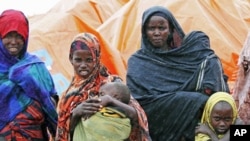Drought and famine are forcing tens of thousands of Somalis to abandon their homes and seek assistance in the capital, Mogadishu, or neighboring countries. The U.N. World Food Program and other agencies say, however, the ongoing conflict in Somalia and actions by the militant group al-Shabab also are to blame for the growing migration.
Aid workers at the Hagadera reception center in Kenya say the number of refugees has increased dramatically since June. Alex Sekai is an emergency response officer.
"We used to receive like 300 to 400, but now it's beyond 1,200, 1,300. The number is shooting [up] every day and we are expecting more," he said.
The lack of food and water in many parts of Somalia is certainly the main reason so many Somalis are fleeing their homes. But Vincent Cochetel, the regional director for the United Nations refugee agency, said fighting and oppression also are causing people to head for the camps.
|
Definition of Famine: The word famine is a term that is not used lightly by humanitarian organizations. The United Nations describes a crisis as a famine only when the following conditions are met:
Current Famine:
|
“When you talk to people in Kenya and Ethiopia, you give them two minutes and ask why they left, they say because of the famine, but you give them 30 minutes, they’ll tell you horror stories about the sort of repression they were confronted with by al-Shabab and other groups,” said Cochetel.
He gave a list of testimonies, including this one.
“20 IDP families from Cochin basketball stadium in the Balad region; all the families were evicted from the basketball stadium after they were told to pay the rent by al-Shabab. They couldn’t afford it. They were expelled from that stadium and they decided to move on,” said Cochetel.
Allan Jury is with the World Food Program. He said the situation is worsening and pleads for better access inside the Horn of Africa nation.
“Right now you have humanitarian emergency across all the areas in the South. You have famine declared in two particular areas, but very honestly, the assessment is, unless there is a rapid assistance and opening up of the country, that anytime over the next one to two months, virtually all of southern Somalia would’ve met the criteria for famine,” said Jury.
But he cautioned against blaming a specific organization.
"[You need] creative ways to deal with local authorities and some of those creative capacities for local dialogue is not necessarily well served by naming a lot [of] names and screaming from top of the podium in the press and media. It can be counterproductive," he said.
The international agency Oxfam says the international community is failing to keep pace with a crisis that is spiraling out of control. Semhar Araia is the group's Horn of Africa regional policy advisor.
“It’s a combination of a lot of things. We’ve got poverty, lack of access to food, children who grew up in wars, a country without a functioning government that’s facing a series of problems regionally. And we have an international community that has been trying to deal with Somalia but has not been adequate enough.”
The United Nations has said 3.7 million Somalis are in need of emergency assistance. It estimates that number of people could rise by 25 percent if urgent action on all fronts is not taken.















